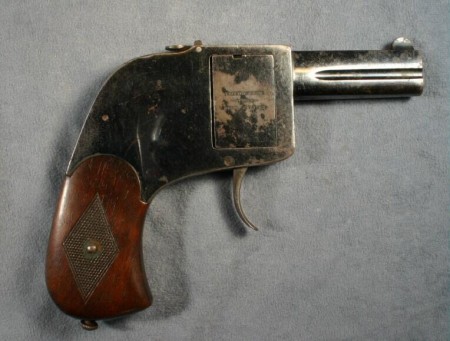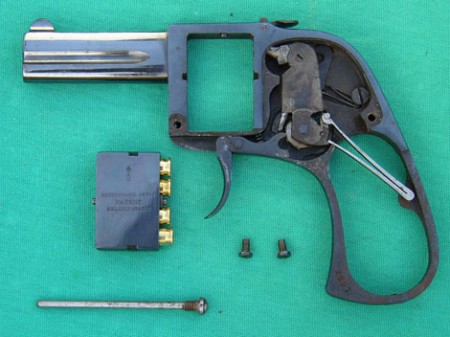Today we have a another guest article by Peter Rasmussen, this time on the subject of a unique and little-known pocket pistol dating to 1899. The Bär was designed as a compact gentleman’s defensive arm with a number of interesting features. These include a “cylinder” or chamber block, which held 4 cartridges in a single column, thus giving the pistol a smooth-sided shape easy to conceal while also giving it double the capacity of a typical double-barreled derringer. Thanks for the info on this unusual piece, Peter!
The Bär Pistol
By Peter Rasmussen
There is some confusion on this pistol and it’s inventor’s name – Behr (or Beahr). On the pistol barrel and in advertisements from the time is the pistol is is called “Bär.”
Description
The Bär is a double barreled revolver, with a square 4-chamber block. The barrel is market “Bär Pistol.” The chamber block is marked “Deutschland, 98382 PATENT”, and on the other side: “Belgien 134215, England, Russia and North America.” It carries the double crowned U Suhl proofmark. The serial number is located on the left side of the barrel, and the Sauer trademark is on the front of the frame. The grip plates are of wood, with different styles of serrations. Hard rubber plates may be encountered (possibly replacements?).

The pistols were manufactured by Sauer & Sohn between 1899 and 1914. Very few were made, as the highest known serial number is below 300.
The original chambering of the pistol was 7 mm Bär rim fire (7×15.5mm), a proprietary cartridge designed in conjunction with it. In 1906 a model in the more common .25ACP (6.35mm Browning) was made available as well. The pistol could be had in black or nickel finish. Burchard Behr had a hunting arms factory in Hamburg, and why Sauer & Sohn made them is not known.
The 7 mm rimfire cartridges were made by G Roth, head stamped: GR – 7mm Bär.

Patents
Burchard Behr was granted a Swiss patent on March 4, 1898 on this design. He also received:
British patent no. 11998 (in this Behr is described as a Russian citizen living in Bendikon, Switzerland)
USA patents 627,966 and 630,478
Swiss patent 16440
German patents no. 98,382 in 2. /11. 1897,
No. 102 624 on 5. /3. 1898
and No 104 616 on 23. /11. 1897.
The German patents were taken in the name of Miss Valleri Schlapal of Zürich, for unknown reasons.
On the cylinder is written that Behr had Belgian patent (no. 13421) and Russian patent.
Function
The chamber block is removed from the pistol, and loaded with 4 cartridges and replaced. The gun will now fire two shots double action. The button on top of the pistol is then depressed and the chamber block turned by hand. The remaining two shots can now be fired.

Sales
The Bär was marketed as a pistol that combined the revolver’s reliability and the flatness of an automatic.
When FN promoted the sale of their model 1900, the competition for the Bär pistol proved too strong and its production stopped. In the Albrecht Kind (Akha) catalog from 1910, it was offered for 42,50 RM and the cartridges 1,25 RM per 100. For comparison, a Roth-Sauer was 40 RM. Adolph Frank (ALFA) offered the Bär in 1911 for 48 RM and 49 RM for a 6.35 mm FN Browning model 1906. After 1914 no dealers offered the Bär pistol for sale.
Sources
Articles in DWJ
J. P. Sauer & Sohn by Jim Cate and Nico van Gun
EU Patent office
Sauer & Sohn Archive
Akha Catalogs
Alfa Catalog from 1911


And there people say you can’t have a square cylinder
Here: http://www.municion.org/7mm/7Baer.htm you can see photos of cartridge for this pistol
I am surprised it hasn’t been updated and produced currently for the concealed carry market.
What if it had one barrel and a flat cylinder that laid parallel to the grip when holstered, then the flat cylinder rotated under spring pressure 90 degrees to one side or the other when unholsteted, then fed through the side of the revolver (in one side, out the other). With each double action indexing the “cylinder” to the next position.
Like the harmonica pistols:
http://www.thefirearmblog.com/blog/wp-content/uploads/2009/11/cub268_z_f1_h-tfb.jpg
The horizontal chamber block was intended to be carried separately, but this wouldn’t exactly make it quick on the draw. Your idea fixes that, albeit with more complexity and cost.
Hello Mr. Rasmussen,
Thank you for writing this article. I have a question concerning the number produced. In your article you mention “the highest known serial number is below 300”. Is this referring to the number manufactured in the first original chambering of 7 mm Bär rim fire (7×15.5mm) with .25ACP (6.35mm Browning) being counted as a separate manufacture run or .25 ACP being counted within the 300 as stated? The reason I ask this question as I have a Bär pistol in .25 ACP with a serial number of 64XX. I may be looking at the wrong number. This number is located on of frame, left grip, bottom corner. Also on the cylinder block, but not on the sides with the patents. But on what coin collectors would call the third face. Any information would be appreciated.
Best regards,
Daniel
Hello, the first mentioned 7mm BAER (BÄR) caliber is NOT a RIMFIRE, but Centerfire…and there was never a Cartrdige with the headstamp GR 7mm BÄR encountered. This caliber does also NOT Show up, in the GR-Catalogue…so I dought, the Info about such a headstamp GR 7mm Bär is not correct..
Sincerely
Forensic Service Wellen, Germany
Hi serius guys
After writing this artikle I Faund Bär pistoæ #23225, so more must have been made. Before that event I only had numbers from 4 pistols all in the 200 series.
My samplr, is defenitly a rimfire, and my cartridge is marked in raised letters as stated.
There are also an artikle in Waffenewvue #96 on this pistol
Do you have any ballistic information about 7mm Bär cartridge – muzzle velocity, bullet weight?
Neat stuff. It doesn’t seem like it would have been that hard to make the “cylinder block” spring loaded so you could fire all four chambers without manual rotation, might have helped them sell more.
This design certainly makes for a nice flat profile! Does the trigger fold forward for pocket carry? I had seen photos of these, but had mistakenly assumed they were a type of vertical “harmonica gun”. What an odd design for a revolver! Again, I cannot help but comment upon the truly beautiful and artistically designed grips on this, fitting in perfectly with those that graced so many handguns of this period.
Yep, the trigger folds forward. Definitely a neat little pistol!
Depending upon the firing pin position being up or down at the moment when a
shot is required, firing sequence of Bar pistol is casual. Therefore, a mechanical
action via trigger movement to rotate the flat revolving magazine would be too
hard and expensive. İnstead, another releaser for magazine rotation near the
trigger could be arranged and made. But, the inventor, appearently preferred more
simpler and cheap hand rotation making the pistol a “Quick reloading double shot
derringer”.
I have number 278 of this gun. I wonder what it is worth?
Mine says 278 and so does one for sale on gun broker right now. Number on left side of barrel must be a model #, not a serial number. My serial # is on the trigger and the left side of the frame under the handle. four digit serial # .25 acp
I also have one with the number 278 on it. That number is on the left side at the rear of the barrels. So perhaps this is not the serial number. Daniel said there is a number on the frame, left grip, bottom corner. The number beneath the grip on mine is 2490. On the inside of the left grip there is a number or some lettering written with a pencil. On the right side of the trigger there is a number which could be read 90 or perhaps 06. The number 2490 also is on one rounded end of the cylinder block.
Any idea what one of these pistols would be worth?
Hi.
I have found this article very interesting. I have begun the purchase of a quite similar pistol, though it is a two shot of larger calibre, thought to be .44 but that is not certain as yet, and there is only one barrel. This pistol also has a trigger guard and exposed hammer spur, so it may be double action or perhaps single action only The operation is the same , after the first shot is fired the locking button is pressed and the square block “cylinder” revolved to bring the second round up in line with the chamber. I have some photos but I don’t know how to send them to you yet. Though I have looked in every site that I can think of the nearest I have found to what I am about top receive, (and I am truly thankful), I know that Rollin White produced a single shot with the chamber in a square block, pivoted at it’s base, this dropped out out to the right, from memory and allowed clearance of the old case and reloading. Having now become aware of the Bar revolver Can you shed any light on my two shot revolver please
Hi, very interesting article. I have a Bär-pistol my dad brought back from Germany in the 45’s.
The number on the barrel is 278. But I notice another on the side o the chamber block (1902 ?)
This one may have belonged to a lady because it has a purse-like white leather holster.
Again thank you for the informations given on this little pistol.
Number 278 = .278 = 7,0612mm = Caliber 7mm Bär!
The caliber of 6.35 has never existed!
Whoever claims to have a pistol in caliber 6.35 should measure the barrel. I look forward to the results!
The number “278” that seems to appear on these pistols may also be the ‘gauge’ of the barrel, as the German proof laws of the time were based on that rather awkward British scale. This would be the bore rather than groove dimension. In the case of 278, that calculates out to .257″ or 6,52 mm. The groove diameter would thus be anywhere from .008″ to perhaps .014″ larger than that, or somewhere around .270″. It would be fascinating to actually slug the bore of one of these pistols!
What are these estimated to be worth today in good condition?
The 300 serial number stuff is definitely wrong. There are serial numbers in the several thousands range. I’ve seen some in the high 3,000-6,000 serial number range.